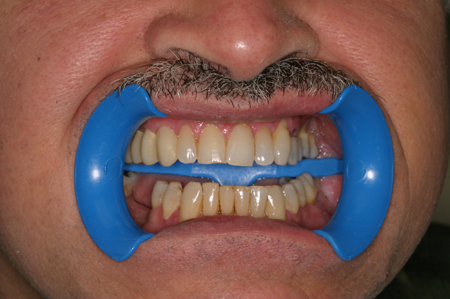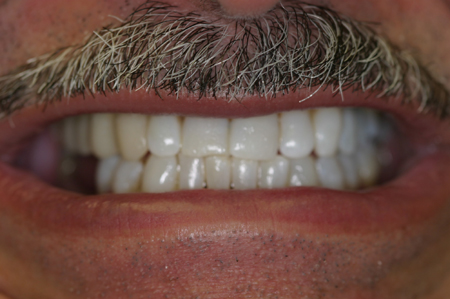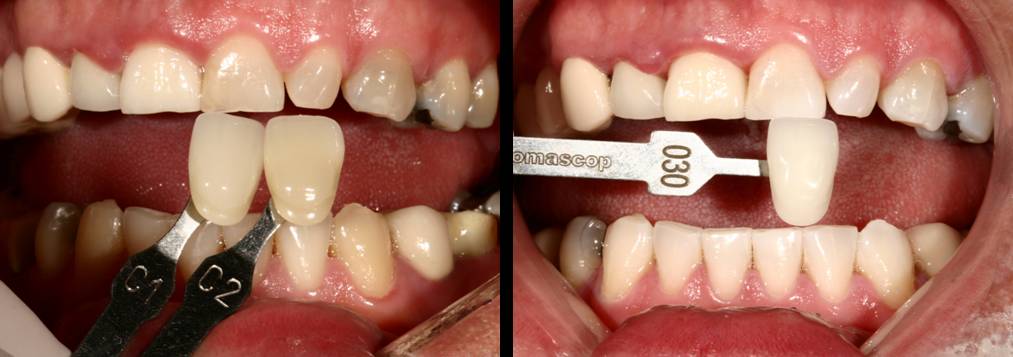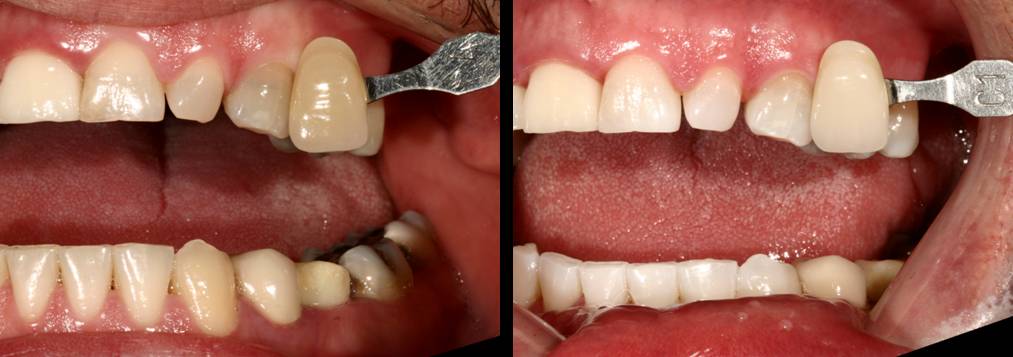Forums › Diode Lasers › General Diode Forum › laser whitening
- This topic is empty.
-
AuthorPosts
-
jetsfanSpectatorI have been using Rod’s technique with consistently great results.
Sorry about that blue cheek retractor.

Robert
dkimmelSpectatorIn my experience and from what I have read— Light makes no difference. The best results I have gotten is using Rod’s techninque as well.
mickey franklSpectatorThanks Robert and David for responding.
very impresive result Robert!
Rods technique involves 2 surgery visits…which light source do you 2 use for this?
Thanks
Mickey
dkimmelSpectatorThere is no light used. It is a combination of Preconditioning in house with bleach, Using a take home bleach and then acid etching doing the final in house bleaching . Hard to believe but it really works well.
PM me with an address
Glenn van AsSpectatorDavid, send me anything new on Rods technique to glennvanas@shaw.ca
I am thinking about the Zoom as the assistant can use that but not the laser at present.
Thanks
Glenn
mickey franklSpectatorGlen,I had a zoom demo last week and the result was very good but the gingival and surrounding tissue protection is very tricky, you realy need to make sure everything is covered as you are using UV light .
I would not be happy for my assistant to do this on her own.
Mickey
Kenneth LukSpectatorHi all,
Not posted anything for a while!
I tried out the Zoom 6 months back but patients complained of sensitivity before the cycles were compltete.
I’ve just started trying out Rod’s technique. Will keep you posted.
ken
kellyjblodgettdmdSpectator
amrezzSpectatorHi all:
Would anyone please email me a detailed discription of Rod’s technique to my email amrezz@link.net
Thank you in advane
Amr
AnonymousGuestRod visits here now and again and has put his technique into a book.
See- http://www.newpatientsinc.com/
books_deepbleach.html
RodSpectatorThanks for emailing me Ron. I’ll try to answer everything that’s come up on this thread. Most have already heard that bleaching lights and lasers are not necessary for bleaching results. Dr. Kanca gave me a lotta crap about this early on, and bless his heart, talked me into doing my own clinicals to confirm what Dr. Christensen and his CRA group found, which is that lights make no difference in the final bleaching results – it’s simply the bleach that you put on the teeth. As you’ll read below, I do a lot of split arch testing of many parameters in bleaching.
Deep Bleaching is not difficult, but as some here already know, if you don’t do it EXACTLY to the letter, you will not get the results. And I’ve found that many dentists just don’t believe that, tend to tweak certain things and then fail. So it’s easy once you know how to do it, but just be sure you follow each and every little thing that I discuss in the book. The book also has 97 color photos, because we dentists can usually do it ourselves if we can SEE it done. And because the technique is no good unless you can sell it, we have included a patient presentation photo album that comes with the book.
I just got a request on the GenX forum for some info, so I’ll just copy below what I answered on there. Problem is that I don’t know how to post photos here on the laser forum, so if you can help me, I’ll be glad to post some pics.
OK, here is the post that I answered with on GenX today.
OK Dawn, you asked for it. It’s not cut ‘n dried yet. So here’s the story:
Where do I start? OK, as many know, I’m the developer of the Deep Bleaching Technique. It’s absolutely incredible in how white it routinely gets teeth – even tetracycline stained teeth. But there are, and always have been negative sides to bleaching. In fact, may patients and dentists choose not to be involved in bleaching at all because of these. There are three main problems:
1) Predictability, which means that it’s difficult to predict how white teeth will get, or if they’ll get whiter at all, and how long it will last. Dentists are tired of not being able to tell their patients what the results will be like, when they don’t really know. You know how it is – you find a product or technique, and the first patient you use it on has very nice results. You’re excited because you finally found the answer. But then on the very next patient, you do and use the same thing, and you have to use your imagination to see a difference, right? So what do you do? Give the patient a refund? Give up dentistry? What?
2) Sensitivity. Wow, when I lecture or have a booth at meetings, the most common question I’m asked is about sensitivity. And I’m not talking specifically about Deep Bleaching, but any bleaching (especially the in-office bleaching such as Rembrandt and Zoom). So I’ve spent the last year and a half diligently looking into this. I’m determined to find the answer.
3) Operatory time. In-office bleaching takes time. And in some states, it takes doctor time, because staff can’t do certain parts of the procedure. There’s dealing with the retractors. Painstakingly placing the paint-on dam. Placing the bleaching gel. Monitoring the patient to be sure they’re OK (remember, if they get that concentrated gel on their tissues, it’s Burn City). Removing and replacing gel at certain intervals. So this takes up a lot of operatory time and staff time. And if you’re tight on operatories, well, it’s just not feasible.
So first, given my desire to conquer the sensitivity issue, I’ve found that products out there that truly don’t cause sensitivity, or only cause say 7% or so as much sensitivity, tend to not get teeth as white. As you may know, for a few years now, I’ve done a lot of clinical testing utilizing split-arch studies. That is the only REAL way to test these things – that way, one side of the mouth is a control. Dividing patients into test groups and control groups is of little benefit – you need to test within the same patient’s mouth (split-arch). For example, I’ve confirmed the tests by Dr. Christensen’s group and found that the lights make no visible difference in results. It’s pretty easy to see the difference from one side to the other side in the same mouth. And it’s easy to document with photographs. The teeth are mirror images of each other, and will typically bleach the same. I’ve done studies where we’ve used one brand on one side, and another on the other side of the split arch. I’ve done split-arch studies utilizing low-sensitivity products on one side, and typical products on the other side. It’s easy to see the difference when a patient then tells you that one side feels great, and the pain is a “10” on the other side. Same thing with trying other methods of sensitivity reduction.
So what I’ve found is that typically when you alter a bleaching material to cause less sensitivity, you also cause less ability to get teeth white. So I’ve been looking in different directions – in addition to trying to figure out how to alter a bleaching material to make it less sensitizing, I’m looking at what can be done to make the tooth less susceptible to sensitivity, yet no less susceptible to whitening.
The other thing is that I’m working on problem #3 above, which is time in the operatory. If I can develop a product that requires no gingival isolation, then the procedure can simply be used by placing the bleaching agent in the Deep Bleaching trays, and simply changing the material out (which takes a couple minutes max) every 20 minutes or so in the office. Heck, the patients could even simply sit in the reception room while doing this if you absolutely didn’t have an operatory available. And most likely, any state laws would allow the dental assistant to simply fill and refill the bleaching trays and hand them to the patient to insert. So the time issue will be far much less of a concern.
I informally teamed up with my friend Al Bevilaqua, owner of Acquamed Technologies some time ago to try to make this all a reality. And we’re in the process of becoming formal partners. The Acquamed bleaching product you ask about is called Acquabrite. It is something that Al developed before I met him. And yes, it does work quite well, but just not AS well in terms of getting teeth as white. The sensitivity issue is really NOT an issue with the product. And you also do not need retractors or paint-on dam with it.
We now have an in-office version and at-home version to fit into the Deep Bleaching Technique – if you’re interested in it, simply ask for the Rod Kurthy Deep Bleaching kit. Dentists have been quite happy with it so far, but you ain’t seen nothin’ yet, because we are actively working on the second generation, which I anticipate will get teeth at least as white as the other popular bleaching products on the market, but without the potential for that acute sensitivity.
So you certainly can use the product right now. But just remember, even though the results are very good, they’re not yet to the point of giving me the SAME wow as say for instance, Zoom for the in-office portion and Opalescence for the at-home. I’d say we’re getting 90+% of the results, but don’t want to mislead anyone into thinking it will be QUITE as “wow” when using my Deep Bleaching Technique.
If you’d like, I can show you some photos from my testing. In fact, I’ll put the results of one case below that actually has some previous crowns so that you can see even better the results. And if you want me to post more pics, just ask.
Al and I anticipate having the second generation products ready in just a few months. To say we’re excited about this is a huge understatement.
So when I get emails asking (which I get at least 50 a week) what products they should use with my Deep Bleaching Technique, my suggestion is that if you’re not concerned with sensitivity, my testing has shown very good results with Zoom and Rembrandt for the in-office part. Problem is that because they had a shipping problem with Rembrandt, where it became too runny during shipping temperatures, they appear to have thickened it up, and now I’ve seen and have heard from many, many others that the Rembrandt now is almost rubbery. So pretty much Zoom is what I’ve been recommending. And for the docs who are not concerned about sensitivity, I tell them that my testing has found that the Opalescence works well for the at-home portion.
Then for the dentist who has great concern about sensitivity, I recommend that they stick to the Acquabrite for both the at-home and in-office.
And finally, for the dentist who tries to anticipate the sensitivity level of the particular patient, then they might want to start out with the Zoom and Opalescence on the typical patient, with the knowledge that they can switch over to the Acquabrite if they need to, and for those patients who seem that they might tend to be sensitivity (history of dentinal hypersensitivity, or light complexion [esp. redheads with freckles]), just start out with Acquabrite.
Anyway, the basic formulation with Acquabrite, plus the system that we’re using to desensitize the tooth itself, looks like we will soon end up with a totally killer bleaching product line that gets teeth totally WOW with my Deep Bleaching approach, causes no acute sensitivity, and hopefully doesn’t even need retractors or paint-on dam. At that point, I anticipate that there will be no reason for any other product that the second generation Acquabrite.
Hope this answers your question. I wanted to be complete so that there’s no misunderstanding.
You should have received a 70-minute DVD from me recently (I sent out over 111,000 of these to dentists in the 50 states). But I totally screwed up on the envelope. The envelope was terrible, and I am aware that many offices simply tossed it, not even knowing there was a DVD inside. So if you didn’t receive one and want one, you can request one from the producer at sohrsmith@columbus.rr.com — just ask for the Rod Kurthy DVD and give your name and mailing address. I think they will also send this up to Canada, and maybe other countries as well if anyone wants.
You can order the Acquabrite at 888-656-9620. And if you want the current products that we’ve put together for the Deep Bleaching results (needs to be used with the Deep Bleaching Technique), just ask for Rod’s Deep Bleaching kit. Or if you simply want the one-visit in-office, or at home bleaching materials, you can ask for them also.
OK, so here is a very representative case. This patient told me that his family says he has rainbow teeth, because they’re all different colors. We used the CURRENT Acquabrite materials on him with my Deep Bleaching Technique. You can see how white that #8 central was prior to bleaching, and how it matched pretty well after bleaching was finished. So the results, with no sensitivity whatsoever, no retractors, no paint-on dam were pretty ‘dam’ good. BUT….not AS good as if we’d used the Zoom and Opalescence. With Acquabrite utilized with my Deep Bleaching Technique, his centrals went from a C2 to an 030. With the Deep Bleaching Technique used with Zoom and Opalescence, he’d have gone to an 020 with no problem. But then again, with all the incisal wear that you can see, and the fact that his teeth are quite sensitive in these areas, I doubt that he’d have been able to tolerate the Zoom or Opalescence. And like I said, in a few months, we anticipate having the next generation of Acquabrite (which I’m working very diligently on right now) that Al and I are confident will totally knock your socks off as far as results (we’re hoping that the results will even be BETTER than when using the Zoom and Opalescence), and STILL not be a sensitivity concern. And like I said, the EASE of use, not needing retractors or paint-on dam is wonderful. We’re also finding that a No-sensitivity bleaching technique is VERY marketable, even if it’s only internal marketing. Many docs are starting out having this simply for their patients who can’t tolerate bleaching due to the sensitivity.
I just tried to download some pics — and it said that they were sucessfully downloaded — but where are they?
Rod
RodSpectatorOK, now I figured it out.
OK, so here is a very representative case. This patient told me that his family says he has rainbow teeth, because they’re all different colors. We used the CURRENT Acquabrite materials on him with my Deep Bleaching Technique. You can see how white that #8 central was prior to bleaching, and how it matched pretty well after bleaching was finished. So the results, with no sensitivity whatsoever, no retractors, no paint-on dam were pretty ‘dam’ good. BUT….not AS good as if we’d used the Zoom and Opalescence. With Acquabrite utilized with my Deep Bleaching Technique, his centrals went from a C2 to an 030. With the Deep Bleaching Technique used with Zoom and Opalescence, he’d have gone to an 020 with no problem. But then again, with all the incisal wear that you can see, and the fact that his teeth are quite sensitive in these areas, I doubt that he’d have been able to tolerate the Zoom or Opalescence. And like I said, in a few months, we anticipate having the next generation of Acquabrite (which I’m working very diligently on right now) that Al and I are confident will totally knock your socks off as far as results (we’re hoping that the results will even be BETTER than when using the Zoom and Opalescence), and STILL not be a sensitivity concern. And like I said, the EASE of use, not needing retractors or paint-on dam is wonderful. We’re also finding that a No-sensitivity bleaching technique is VERY marketable, even if it’s only internal marketing. Many docs are starting out having this simply for their patients who can’t tolerate bleaching due to the sensitivity.

Now, this is the same patient – see that his cuspid went from about a C-4 to a C-1. Not too shabby for a non-sensitizing bleaching formula. So we’re very, very pleased with where we’ve gone so far, and actually very proud of what we’ve achieved even now. But just wait – you ain’t seen nothin’ yet!

Rod
whitertthSpectatorGreat case Rod…..Hoping to see you and hear you speak at LDF’S first annual meeting…( no pressure of course)
In Friendship.
RodSpectator…( no pressure of course)
LOL!!!!!
Rod
ASISpectatorRod,
Great result! The lowers came out quite well too, especially the lower left canine.
Keep us posted on this 2nd generation product.
Thanks.
Andrew
-
AuthorPosts
